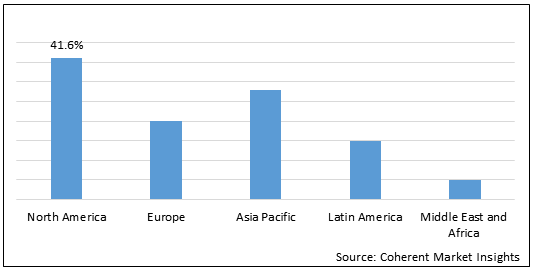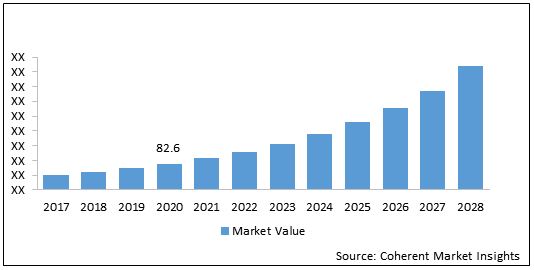
The introduction of the fourth dimension (4D) to the third dimension (3D) is known as 4D printing technology. With the help of 4D, the created 3D object possess the capability to change its shape by itself over the influence of external stimuli such as heat, light, electricity, magnetic field, and others. Thus the capability of objects to transform their structure over time by using the behavior of different materials is termed as 4D printing and it does not require human intervention in the process. Furthermore, increasing need for flexible objects in various applications such as adaptive wind turbines, self-folding packaging, and others, has created the emergence of 4D printing in the market.
The global 4D printing market is expected to witness significant growth during the forecast period (2021–2028). The rising demand for innovation in 3D printing applications and considerable research & development is expected to drive the global 4D printing market growth during the forecast period. The 4D technology is the advance version of the 3D technology, which offers improved quality, efficiency, and performance capabilities over the traditional manufacturing techniques. The technology used in 4D technology develops materials that have the ability to change their behavior and properties based on change in temperature, pressure and so on. For instance, in March 2016, Airbus SAS, a European based aerospace company announced partnership with MIT’s Media Lab, a U.S. based research Lab worked with 4D printing technology in order to develop a solution that will cool its engines depending on temperature and other factors. They have developed air inlet component that can transform in response to aerodynamic conditions to decrease air resistance. In addition, the growing need for reducing manufacturing and processing cost, owing to the high competition, is also fueling the market growth in the future. Several companies have also started adopting these advanced 4D printing technologies in order to develop high quality products for the users. These 4D printing products have lesser manufacturing, transportation, and handling costs, which in turn, would lead to the saving of resources and efforts, thereby sustaining the environment.
Global 4D Printing Market - Impact of Coronavirus (Covid-19) Pandemic
COVID-19 has significantly disrupted almost all the industries including infrastructure, transportation, oil and gas, manufacturing, and others. To combat COVID-19 pandemic, most of the countries implemented lockdown and are now easing it phase-wise and industry wise. This has significantly impacted manufacturing sector, as the facilities across the globe were temporarily shut down. However, the COVID-19 pandemic has decreased the demand for 4D printing in the healthcare industry. Due to COVID-19 pandemic, several industries witnessed significant shift in their business. There is significant impact on the global 4D printing market, as healthcare industries has suffered a lot due to this pandemic. During this time of social and economic despair, most of the healthcare industries are under stress due to shortage of beds and medical equipment’s. There are disruption in the supply chain of these medical equipment throughout the U.S., Europe, and India, and due to this there is a shortage of medical equipment and kits. For instance, in Italy, there is a shortage of medical equipment’s and PPE kits for the protection of the health workers in the hospitals. This increasing demand of 4D printing in medical sector is fueling the market growth.
North America held dominant position in the global 4D printing market during the forecast period.
Statistics:
Among regions, North America held dominant position in the global 4D printing market in 2020, accounting for 41.6% share in terms of value, followed by Asia Pacific and Europe.
4D Printing Market Report Coverage
| Report Coverage | Details | ||
|---|---|---|---|
| Base Year: | 2020 | Market Size in 2021: | US$ 82.6 Mn |
| Historical Data for: | 2017 to 2019 | Forecast Period: | 2021 to 2028 |
| Forecast Period 2021 to 2028 CAGR: | 29.4% | 2028 Value Projection: | US$ 625.6 Mn |
| Geographies covered: |
|
||
| Segments covered: |
|
||
| Companies covered: |
Stratasys Ltd., 3D Systems Inc., Autodesk, Inc., Hewlett Packard Corp., ExOne Corporation, Organovo Holdings, Inc., Materialise NV, Dassault Systèmes, ARC Centre of Excellence for Electromaterials Science (ACES), Heineken NV, Norsk Titanium US Inc., Aerojet Rocketdyne Holdings Inc., and Engineering & Manufacturing Services Inc. |
||
| Growth Drivers: |
|
||
| Restraints & Challenges: |
|
||
Uncover macros and micros vetted on 75+ parameters: Get instant access to report
Figure 1: Global 4D Printing Market Share (%), By Region, 2020

To learn more about this report, Download Free Sample
North America is expected to account for the largest market share during the forecast period, owing to the increasing investments by the U.S. Government into the 4D technology in the market. For instance, the U.S. Department of Defense (DoD) is planning to adopt additive manufacturing in airspace industry. Several companies are investing in new programs to integrate 4D printing technology into the U.S. Army and U.S. Air Force manufacturing operations. For instance, in November 2017, America Makes announced a Project Call for Phase III of the Maturation of Advanced Manufacturing for Low-Cost Sustainment (MAMLS) program, funded by the Air Force Research Laboratory (AFRL), a U.S. based research organization. This project is used to improve rapid part replacement/maintenance for legacy aircraft, enable on-demand replacement of critically damaged or obsolete components, and reduce the lead time to fabricate replacement components.
Asia Pacific region is expected to exhibit highest growth during the forecast period, owing to the rising construction industry in the region. 4D printing companies develop machines that can change their shape as per the working environment conditions. For instance, countries such as India and China have a huge urban population and have created huge demand for 4D printing market in the Asia-Pacific region. For instance, the population of China has reached 1,400.0 million in 2019 from 1,395.3 million in 2018.
Military & defense segment is expected to drive the market growth during the forecast period.
Among end user, military & defense segment is expected to hold dominant position in the global 4D printing market during the forecast period. The military sector of various countries has been adopting 3D printing technologies to assists soldier to combat missions and operations. For instance, the U.S. Army Research Center is developing applications such as a soldier’s uniform that can alter its own camouflage or provide more effective protection against poisonous gases. These 4D technologies are used for producing machinery, guns, and other defense technologies, which in turn increases the segment growth during the forecast period.
Figure 2: Global 4D Printing Market Value (US$ Mn) Analysis and Forecast and Y-o-Y Growth (%), 2017 - 2028

To learn more about this report, Download Free Sample
The global 4D printing market was valued at US$ 82.6 Mn in 2020 and is expected to reach US$ 625.6 Mn by 2028 at a CAGR of 29.4% between 2021 and 2028.
Major players operating in the global 4D printing market include Stratasys Ltd., 3D Systems Inc., Autodesk, Inc., Hewlett Packard Corp., ExOne Corporation, Organovo Holdings, Inc., Materialise NV, Dassault Systèmes, ARC Centre of Excellence for Electromaterials Science (ACES), Heineken NV, Norsk Titanium US Inc., Aerojet Rocketdyne Holdings Inc., and Engineering & Manufacturing Services Inc.
Share
Share
Missing comfort of reading report in your local language? Find your preferred language :
Transform your Strategy with Exclusive Trending Reports :
Frequently Asked Questions
Select a License Type
Joining thousands of companies around the world committed to making the Excellent Business Solutions.
View All Our Clients